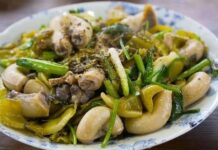1 How to Choose Fresh and Safe Rice Noodles
– Color: Rice noodles that haven’t been bleached will have an ivory color similar to rice grains, and they’ll turn opaque white after cooking.
– Taste: As they are made from pure rice, delicious rice noodles will have a taste similar to rice, without any sourness.
– Noodle strands: The strands should be evenly long and have a certain chewiness.
– Water after blanching the noodles: The water should be clear and slightly viscous, and it will have the fragrant smell of rice due to the absence of additives.
When choosing industrially produced rice noodles, pay attention to the expiration date.

2 How to Stir-Fry Rice Noodles Without Breaking or Sticking
Step 1: Prepare the Rice Noodles
– Soak in cold water: Soak the noodles in cold water for 10-15 minutes. Gently squeeze the noodles until they feel slightly soft, then shake them lightly to separate the strands and remove them from the water.
– Boil or blanch the noodles: If you want the noodles to have a chewy texture, either boil them or blanch them quickly in boiling water over high heat. After blanching, plunge the noodles into ice water, then drain and set aside.
– Toss the noodles: To prevent the noodles from sticking together, you can toss them with a small amount of cornstarch or egg white. Additionally, to enhance the fragrance and taste of the noodles, add a teaspoon of vinegar and toss to coat evenly before stir-frying.

Step 2: Stir-Fry the Rice Noodles
Stir-fry the vegetables, meat, and seafood first, adding seasonings as you go. Then, add the noodles and mix well for about 3 minutes. Turn off the heat when the noodles have slightly softened and are still a bit chewy.
Divide the oil into two portions. For the first portion, use about a teaspoon of oil to fry the garlic and shallots until fragrant and golden. Add the remaining oil after adding the noodles. This way, you’ll save oil and ensure that the oil is evenly distributed, making the dish more appetizing.

Recognizing Spoilage and Best Practices for Storing Milk
Dien May XANH is advocating for the careful storage of milk to ensure people consume the nutrition-rich beverage that is safe and healthy. Milk, a source of vitamins and minerals essential to our bodies’ functioning, can become tainted if not properly handled, causing painful, and in some cases, severe gastrointestinal distress.




































